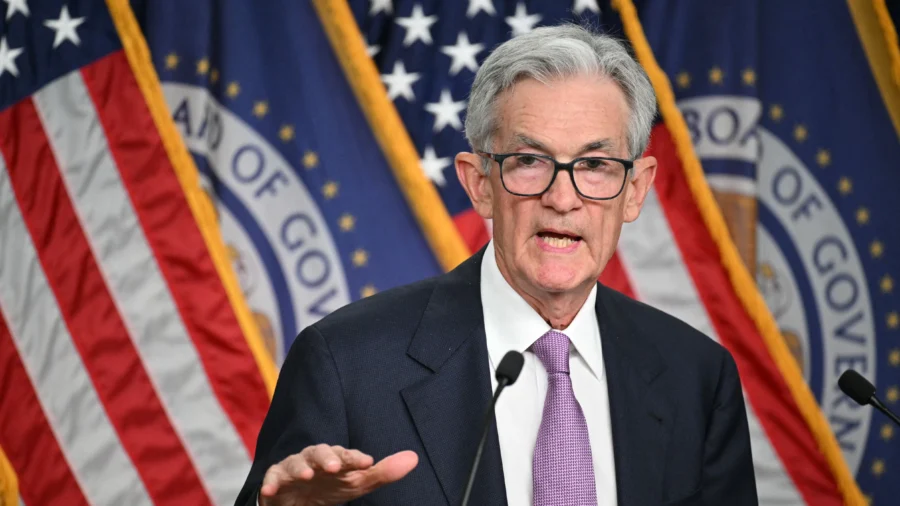Federal Reserve Chair Jerome Powell dismissed allegations that the central bank’s first interest rate cut since March 2020 will affect the presidential election in November.
The Fed kicked off the easing cycle on Sept. 18 with a half-point cut to the benchmark federal funds rate.
Speaking to reporters at the post-meeting press conference, Powell was asked about the timing of the rate cut, which came less than 50 days before voters head to the ballot box, and whether it has political motivations.
“This is my fourth presidential election at the Fed, and it’s always the same. We’re always going into this meeting in particular and asking what’s the right thing to do for the people we serve?” Powell said. “And we do that and we make a decision as a group, and then we announce it. And it’s, that’s always what it is, it’s never about anything else.”
Powell said that the things the Fed does “really affect economic conditions for the most part with a lag,” and that if the Fed loosens monetary policy conditions correctly, these actions will “benefit the American people significantly.”
Conventional economic wisdom suggests that monetary policy functions with a long and variable lag, a concept derived from Milton Friedman’s research and literature. This means that Fed policy actions might not be seen instantly, though the subject has been open to debate in recent years.
Leading up to the long-awaited rate reduction, Powell repeatedly said in press conferences and interviews that the central bank does not consider elections or politics in its decision-making, referencing the institution’s independence.
The Fed’s rate cut announcement captured attention on Capitol Hill.
“We just reached an important moment: Inflation and interest rates are falling while the economy remains strong,” President Joe Biden wrote on X on Sept. 18. “The critics said it couldn’t happen—but our policies are lowering costs and creating jobs.”
Vice President Kamala Harris said the Fed policy pivot was “welcome news for Americans who have borne the brunt of high prices.”
“I know prices are still too high for many middle class and working families, and my top priority as President will be to lower the costs of everyday needs like health care, housing, and groceries,” Harris said in a statement on Sept. 18.
Some lawmakers also shared their thoughts.
Sen. Tommy Tuberville (R-Ala.) said the cut was “shamelessly political” and that the Fed “has no business moving rates” so close to an election.
Just days before the highly anticipated meeting, Sen. Elizabeth Warren (D-Mass.) pushed the Fed to cut interest rates by 75 basis points because “now is the time to swiftly move forward with rate cuts.”
“I guess it shows the economy is very bad to cut it by that much, assuming they’re not just playing politics,” former President Donald Trump told reporters shortly after the Fed’s decision and ahead of his Long Island rally. “The economy would be very bad, or they’re playing politics, one or the other. But it was a big cut.”

In May, the Republican presidential candidate told Bloomberg that cutting interest rates before the election is “something that they know they shouldn’t be doing.”
Federal Reserve, Elections
This is not the first time the Fed has raised or lowered interest rates ahead of an election.
According to data compiled by Comerica Wealth Management, the central bank has changed interest rates in 10 of the past 11 presidential election years. In 2012, the monetary authorities left rates unchanged but they were already close to zero percent because of the third edition of quantitative easing.
While the effects of up or down movements in the policy rate may not be witnessed for several months—or a few years—some White House incumbents have encouraged the Fed to pause rate hikes or initiate a series of cuts heading into an election.
Most famously, President Richard Nixon, leading up to his re-election, pressured then-Fed Chair Arthur Burns to launch expansionist monetary policies, including rate cuts.
From Burns’s appointment in February 1970 to November 1972, the central bank reduced the federal funds rate from 8.71 percent to 5.06 percent.
“The Fed and the money supply are more important than anything the Bureau of the Budget does,” Nixon said in a conversation with Burns on Oct. 23, 1969, just after his nomination to the Fed had been announced. “I know there’s the myth of the autonomous Fed.”
More recently, Trump and Biden have weighed in on Fed policy during their terms in office.
In a December 2023 speech in Las Vegas, Biden discouraged the Fed from raising rates because the U.S. economy was in a “sweet spot that’s needed for stable growth and lower inflation, not encouraging the Fed to raise interest rates.”
In the run-up to the December Fed policy meeting, monetary officials indicated they were not thinking about rate cuts. However, the institution signaled three rate cuts in 2024.
Trump has been a vocal critic of the Federal Reserve, both in his first term and on the 2024 campaign trail.
Writing in a Sept. 11, 2019, X post, Trump said the Fed should slash interest rates to “zero, or less, and we should then start to refinance our debt.”
Eight days later, the Fed pulled the trigger on a quarter-point rate cut, lowering the federal funds rate to a range of 1.75 percent to 2 percent. This was followed by another mid-cycle 25-basis-point reduction in October 2019 that was, according to the Fed chair, meant to build “on the gains so far and spreading the benefits more broadly to all Americans.”
‘Long, Variable Lags’
Central Banking 101 operates on the decades-old premise of long and variable lags because, for example, many marketplace transactions by buyers and sellers are based on prices and volumes agreed upon months in advance. While there is no rule of thumb, adjustments to policy may not be experienced for as long as 24 months, according to a blog post from the St. Louis Fed.
“It’s sort of standard thinking that monetary policy affects economic activity with long and variable lags,” Powell told reporters at a June 2023 post-meeting press conference.
Economists and even Fed officials have started to take another look at the concept.
Fed Gov. Christopher Waller recently said that lags might be shorter than previously thought. Citing the central bank’s forward guidance, which was not the routine procedure before the early 2000s, Waller estimated that monetary policy effects could be viewed in as little as nine months.
“Forward guidance shortens the lag time between when the policy rate changes and when the effects of actual policy tightening occur,” Waller said in a Money Marketeers of New York University event speech in July 2023.
Waller said that when sizable shocks occur, be it in the wider economy or on policy, there will be a rapid response.
“Big changes in policy rates will tend to cause more rapid changes in behavior, which implies monetary policy lags will be shorter when changes to the policy rate are large and rapid,” he said.
With a vast dashboard of daily, weekly, and monthly economic and financial indicators, markets and consumers can telegraph monetary policy well in advance.
Bond markets started pricing in rate cuts this past spring, with the benchmark 10-year Treasury yield sliding 100 basis points to 3.74 percent.
As for stocks, traders will instantly respond to rate cuts.
One day after the Fed’s jumbo rate cut, the leading benchmark indexes rallied as much as 2.6 percent.
According to stock market numbers put together by the Chase Investment Council, the S&P 500 has delivered sizable one-year returns after the Fed’s first rate cut.
From The Epoch Times

